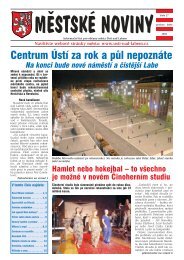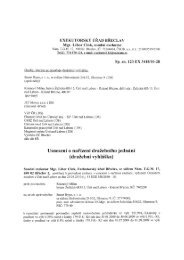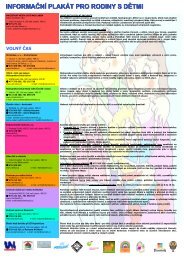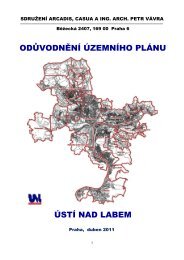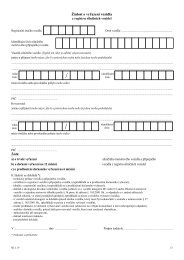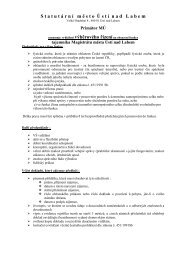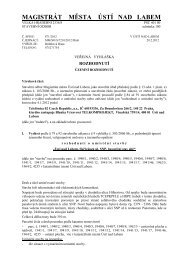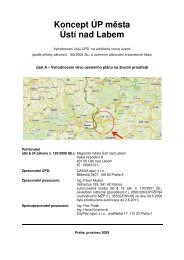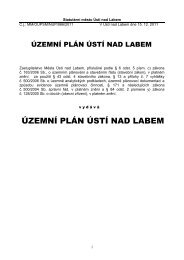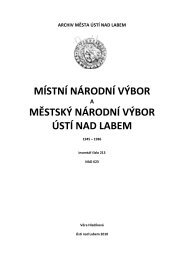Historie a památky města Ústí nad Labem History and monuments of ...
Historie a památky města Ústí nad Labem History and monuments of ...
Historie a památky města Ústí nad Labem History and monuments of ...
Erfolgreiche ePaper selbst erstellen
Machen Sie aus Ihren PDF Publikationen ein blätterbares Flipbook mit unserer einzigartigen Google optimierten e-Paper Software.
10<br />
CZ ENG DE<br />
roce 1126 se v okolí hradiště odehrála jedna z nejvýznamnějších<br />
bitev českých dějin, v níž český kníže Soběslav I. porazil<br />
německého císaře Lothara III. Na paměť tohoto vítězství byla<br />
tehdy obnovena rotunda sv. Jiří na hoře Říp. Chlumecké hradiště<br />
však stále více ztrácelo na významu ve prospěch <strong>Ústí</strong> <strong>nad</strong><br />
<strong>Labem</strong>, které těžilo ze své výhodné polohy na soutoku Labe a<br />
Bíliny. V průběhu první poloviny 13. století hradiště v Chlumci<br />
zaniklo.<br />
Jak ukázaly archeologické výzkumy, ústecké hradiště se rozkládalo<br />
v jižní části pozdějšího historického centra <strong>města</strong>, mezi<br />
Bílinou a Klíšským potokem, který areál obtékal ze severu a<br />
východu. Rozloha hradiště rozčleněného do dvou částí dosahovala<br />
asi 3 hektarů. Jeho jádro, opevněné důkladně valem s dřevohlinitou<br />
konstrukcí a širokým příkopem, se nacházelo podél<br />
nynější ulice Hradiště. V této lokalitě stál původní chrám sv. Vojtěcha<br />
», kde se 23. dubna (tedy právě v den svátku tohoto světce)<br />
roku 1186 konala svatba Ž<strong>of</strong>ie, dcery českého knížete Bedřicha,<br />
s Albrechtem, synem míšeňského markraběte Oty. Větší,<br />
západní část hradiště tvořilo patrně jen lehčeji opevněné předhradí.<br />
Také zde se nacházel nejpozději ve třetí čtvrtině 12. století<br />
románský kostel, z něhož se dodnes dochovala spodní část<br />
mohutné západní věže, později goticky přestavěné.<br />
Důležitou součástí raně středověkých center byla tržiště, kam<br />
se soustřeďoval hospodářský život. Tržiště se vždy rozkládala<br />
mimo obvod hradiště, v případě <strong>Ústí</strong> patrně severovýchodně od<br />
něj, na Předmostí, nebo v prostoru pozdějšího náměstí, kde<br />
byly zjištěny doklady intenzivního raně středověkého osídlení<br />
11. a 12. století. Poplatky z cel a trhů se významně podílely na<br />
knížecích příjmech, zčásti ale také sloužily k finančnímu zajištění<br />
nově zakládaných církevních institucí, kterým panovník přenechával<br />
vždy jednu desetinu z celkových výnosů. V <strong>Ústí</strong> tak<br />
postupně obdržely desátý, devátý a osmý díl z příjmů český nejstarší<br />
mužský benediktinský klášter v Praze-Břevnově, klášter<br />
benediktinek u sv. Jiří na Pražském hradě a konečně v roce<br />
1057 také nově založená litoměřická kapitula. Kontakty s břevnovským<br />
klášterem, u jehož založení stál pražský biskup sv.<br />
Vojtěch, se zřejmě odrazily i ve volbě zasvěcení již zmíněného<br />
knížecího chrámu v ústeckém areálu.<br />
Jestliže v 10. století spočíval význam hradiště hlavně v jeho<br />
strategické poloze v tehdy vlastně okrajové a jen slabě obývané<br />
části Čech, v průběhu 12. století došlo v jeho zázemí k pronikavým<br />
změnám. Osídlení se začalo cílevědomě rozšiřovat;<br />
osami postupu se staly stezky, které spojovaly dosud poměrně<br />
izolované území Ústecka s dalšími centry raně středověkých<br />
Čech. Nelze zapomínat, že všechny tyto cesty vedly původně<br />
vnitrozemím přes kopce Českého středohoří; Labe sice bylo<br />
gious institutions. The Czech oldest Benedictine monastery at<br />
Prague – Břevnov, then the Benedictine nunnery at St. George´s<br />
at the Prague Castle <strong>and</strong> finally, in 1057, also the newly<br />
founded Litoměřice Canonry received the tenth, ninth as well as<br />
the eight part <strong>of</strong> the income in <strong>Ústí</strong>. Contacts with the Břevnov<br />
monastery, founded by the Prague bishop St. Adalbert, were<br />
most probably also reflected in the fact that the already mentioned<br />
prince´s church was consecrated in <strong>Ústí</strong> <strong>nad</strong> <strong>Labem</strong>.<br />
The importance <strong>of</strong> the fort hill in the 10th century consisted<br />
mostly in its strategic position in the then borderline <strong>and</strong> only<br />
scarcely inhabited part <strong>of</strong> Bohemia. However, during the 12th<br />
century, the inl<strong>and</strong> faced dramatic changes. The settlement<br />
started systematically to exp<strong>and</strong>; the main streams proceeded<br />
on the routes connecting the so far rather isolated area <strong>of</strong> the<br />
<strong>Ústí</strong> region with other centres <strong>of</strong> the Early Medieval Bohemia.<br />
It has to be noted, that all the routes originally led through the<br />
inl<strong>and</strong> across the hills <strong>of</strong> the Bohemian Upl<strong>and</strong>s. The River Labe<br />
was used as a transport route, however, its banks were difficult<br />
to pass until the 19th century. The so called “internal colonisation”<br />
was organised by the ruler with his family <strong>and</strong> by him<br />
supported religious institutions (in the <strong>Ústí</strong> region there were<br />
particularly the knights <strong>of</strong> the Order <strong>of</strong> St. John), but also by<br />
representatives <strong>of</strong> nobility, <strong>of</strong> which brothers Měšek <strong>and</strong> Hroznata<br />
<strong>of</strong> Peruc took the most active part.<br />
Domain around Levín<br />
The process <strong>of</strong> the internal colonisation in the <strong>Ústí</strong> region is<br />
interesting to trace on the Deed <strong>of</strong> King Vladislav from 1169.<br />
The king was a supporter <strong>of</strong> the Order <strong>of</strong> St. John <strong>and</strong> he made<br />
a lot <strong>of</strong> donations in favour <strong>of</strong> the Order. The Order <strong>of</strong> St. John<br />
in the <strong>Ústí</strong> region was donated villages Bořislav <strong>and</strong> Hrbovice<br />
situated along the Serbian route, as well as a vast forested<br />
domain in the <strong>Ústí</strong> upl<strong>and</strong>s, the borders <strong>of</strong> which were restricted<br />
by the only then existing villages around the circumference <strong>of</strong><br />
the concerned territory, i.e. Levín (today´s Libov) in the west <strong>and</strong><br />
Prosetín in the east. The domain also involved the eastern part<br />
<strong>of</strong> the forest Chvojen at the upper stream <strong>of</strong> the Klíšský Brook.<br />
The reason for this is explained in the later documents, according<br />
to which the western part, where the villages <strong>of</strong> Božtěšice,<br />
Strážky <strong>and</strong> Žďár were founded, passed to the Benedictine nunnery<br />
<strong>of</strong> St. George at the Prague Castle. In the late 12th century,<br />
the Order <strong>of</strong> St. John initiated the foundation <strong>of</strong> a number <strong>of</strong><br />
smaller settlements in their domain. Their names (e.g. Mnichov,<br />
Slavošov, Lysá) as well as the way how their ground-plan <strong>and</strong><br />
farming l<strong>and</strong> were laid show that the domestic Czech inhabitants<br />
were arriving here. The process <strong>of</strong> settlement <strong>of</strong> the<br />
domain lasted until the 13th century with already first communities<br />
<strong>of</strong> German colonists. Germans brought a new appea-<br />
das neugegründete Leitmeritzer Kapitel jeden zehnten, neunten<br />
und achten Teil der Einkommen. Die Kontakte mit dem Břevnov-<br />
Kloster, bei dessen Gründung der Prager Bisch<strong>of</strong> Hl. Vojtěch<br />
vorst<strong>and</strong>, zeigten sich wahrscheinlich auch in der Wahl der Einweihung<br />
des bereits erwähnten Fürstendoms im Aussiger Areal.<br />
Falls im 10. Jahrhundert die Bedeutung der Burgstätte vor<br />
allem in ihrer strategischen Lage im damals peripheren und nur<br />
wenig besiedelten Teil Böhmens lag, so kam es im Laufe des<br />
12. Jahrhunderts in ihrem Hinterl<strong>and</strong> zu signifikanten Änderungen.<br />
Die Besiedlung fing an, sich gezielt auszubreiten; die<br />
Wege, die das bisher ziemlich isolierte Gebiet der Region <strong>Ústí</strong><br />
<strong>nad</strong> <strong>Labem</strong> mit <strong>and</strong>eren Zentren des frühmittelalterlichen Böhmens<br />
verknüpften, wurden zu den Achsen des Vorgehens. Man<br />
darf nicht vergessen, dass all diese Wege ursprünglich durch<br />
das Innl<strong>and</strong> über die Hügel des Böhmischen Mittelgebirges<br />
führten; die Elbe war zwar eine Wassertransportader, allerdings<br />
ihre Ufer blieben bis zum 19. Jahrhundert schwer befahrbar. Zu<br />
den Organisatoren dieser sog. inneren Kolonisierung gehörte<br />
nicht nur der Herrscher und seine Familie und von ihm unterstützte<br />
Religionsinstitutionen (in der Region <strong>Ústí</strong> h<strong>and</strong>elte es sich<br />
vor allem um den Ritterorden der Johanniter), sondern auch<br />
Angehörige des Adels, von denen die Gebrüder Měšek und<br />
Hroznata aus Peruc an dem Besiedlungsprozess einen bedeutenden<br />
Anteil nahmen<br />
Levínský újezd<br />
Den Prozess der inneren Kolonisierung in der Region <strong>Ústí</strong> <strong>nad</strong><br />
<strong>Labem</strong> bringt uns die Urkunde des Königs Vladislav aus dem<br />
Jahre 1169 nahe. Der Herrscher war Angehöriger des Ritterordens<br />
der Johanniter, zu dessen Gunsten er eine noble Gabe<br />
tätigte. In der Region <strong>Ústí</strong> erhielten die Johanniter sowohl die<br />
Dörfer Bořislav und Hrbovice, die auf der Strecke des serbischen<br />
Weges lagen, als auch einen großen Waldbezirk im Mittelgebirge<br />
von <strong>Ústí</strong>, dessen Grenzen von zwei bisher existierenden<br />
Dörfern am R<strong>and</strong> des abgegrenzten Gebietes beschränkt<br />
wurden, und zwar Levín (heute Libov) im Westen und Prosetín<br />
im Osten. Zum Best<strong>and</strong>teil des Bezirkes gehörte auch die östliche<br />
Hälfte des Waldes Chvojen am oberen Strom des Klíšský<br />
Baches. Warum dies so war, erklären spätere Dokumente, laut<br />
deren der westliche Teil, an dem die Dörfer Božtěšice, Strážky<br />
und Žďár gegründet wurden, den Konvent der Benediktinerinnen<br />
vom Hl. Jiří an der Prager Burg erhielt. Die Johanniter initiieren<br />
in der zweiten Hälfte des 12. Jahrhunderts in ihrem Bezirk<br />
die Gründung von einer Reihe kleinerer Siedlungen, deren<br />
Namen (z.B. Mnichov, Slavošov, Lysá) und wie die Art und<br />
Weise der Anordnung des Grundrisses und der l<strong>and</strong>wirtschaftlichen<br />
Nutzflächen verraten, dass hiesige tschechische Bevölkerung<br />
hierher käme. Die Besiedlung des Bezirks zog sich bis



